
For kids with epilepsy, a special unit offers around-the-clock care at Children’s Wisconsin
Mackenzie Connerton sits in her room on the seventh floor of Children’s Wisconsin slathering red paint onto a small wooden birdhouse. Thick beads slowly stream down its small pitched roof. Just off to the side sit two other freshly painted birdhouses, a brightly colored tally of the number of days she’s been there. With the walls still bare, Mackenzie puts down her brush and pushes away from the table.
Her head is covered in a white mesh wrap and a long clump of cables flow from the back of her head like a tangled marionette. As she walks across the room in search of a different toy, the knot of wires drags behind her along the ground. Each step is slow and deliberate as she’s careful to avoid tripping. She finds a Trolls puzzle in a drawer and then settles into bed.
Tracking Mackenzie’s brain activity
Meanwhile, in a room just down the hall, a team of doctors and nurses are seated in a control room before a wall of 28 high-definition monitors, tracking her and her brain’s every move. This is the Epilepsy Monitoring Unit (EMU) at Children’s Wisconsin.
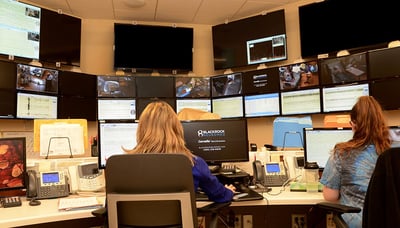
“The Epilepsy Monitoring Unit is a state-of-the-art neuromonitoring center,” said Kurt Hecox, MD, medical director of neurology and Mackenzie’s primary neurologist. “We provide expert, specialized care 24 hours a day to children living with epilepsy.”
Caring for upwards of 3,000 kids each year, Children’s Wisconsin has one of the largest pediatric epilepsy centers in the country. There are 16 rooms total in the unit — each equipped with three high-speed, high-definition cameras — plus another 12 compatible rooms in the ICU.
Currently, six kids are under observation, all seemingly oblivious to the cameras watching overhead. On one screen a baby is swaddled in a cotton blanket, sleeping peacefully. On another an older child is curled up in a chair, playing on an iPad. And then there’s Mackenzie, sitting quietly in her bed.
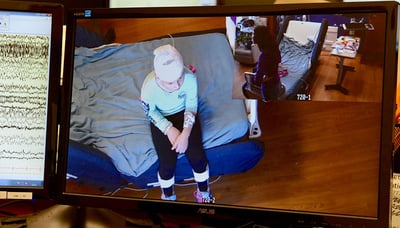
Mackenzie was diagnosed before she was born
Tiffany long ago lost count of how many days her 9-year-old daughter, Mackenzie, has spent in Children’s Wisconsin. In fact, Mackenzie’s first visit occurred about three months before she was even born.
A radiation therapist by trade, Tiffany was at work when she and some of her co-workers were looking at an ultrasound of the baby. One of her tech friends noticed something.
The next day Tiffany was at Children’s Wisconsin’s Fetal Concerns Center where she received a diagnosis of hydrocephalus.
Hydrocephalus is a buildup of cerebrospinal fluid in the brain that creates harmful pressure. Normally, the brain has two ventricles that drain the fluid and stabilize pressure, but Mackenzie’s right ventricle didn’t develop properly. While there is no direct connection between hydrocephalus and epilepsy, the two conditions are often seen together in patients.
“My previous ultrasound at 20 weeks was completely normal. They even went back and checked it again. So it had developed rapidly after that,” said Tiffany. “Without that ultrasound, they said they wouldn’t have known unless she had seizures after she was born or if she had come out with an oversized head, which is another sign. Otherwise they wouldn’t have known until something happened.”
Mackenzie’s seizures
On October 16, 2008 — three days before she was scheduled to be induced — Mackenzie Elizabeth was born. Two weeks later, she underwent brain surgery to insert a shunt to help drain the excess fluid and relieve pressure. After that, life carried on with relatively little issue.
But shortly after Mackenzie turned 4, the seizures started.
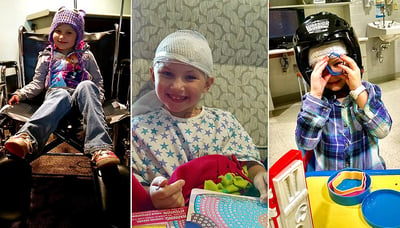
“I remember very clearly her first seizure,” Tiffany said. “It was a Friday. I had just picked her up from the sitter’s house. As we pulled out of the driveway she said, ‘Mommy, I don’t feel good.’”
Tiffany quickly parked the car and took Mackenzie to the front lawn in case she threw up. She held her there in the grass for a minute and everything seemed fine. But when they got up, Mackenzie couldn’t walk straight. She kept veering off to the left. Tiffany carried her back to the car, at which point Mackenzie had become unresponsive, just staring blankly, with her head frozen to the left. Terrified and confused, Tiffany raced to a nearby hospital.
“I was so scared. All I could think is I need help now,” Tiffany said. “I had to carry her into the ER and I broke into tears telling the lady I needed help. She asked me what was wrong and I had to tell her I had no idea.”
The ER doctor immediately recognized Mackenzie was having a seizure. Once it was treated with medication and Mackenzie was stable, she was transported by helicopter to Children’s Wisconsin.
“Since that day, the neurology floor has become our second home,” said Tiffany, who lives an hour away in Winthrop Harbor, just over the border in Illinois. “I know that when we walk onto the floor I’m going to see familiar and caring faces and it puts my mind at ease a little. That means the world to me.”
As a result of the seizure activity, Mackenzie has several cognitive delays. She’s in third grade but is unable to read. She can write her name but she does so in all caps and it usually takes up two lines as she struggles with letter spacing. She has a condition called nystagmus, which can cause vision impairment and impact balance and coordination. And she has issues with personal space — her mom says she loves to touch everybody.
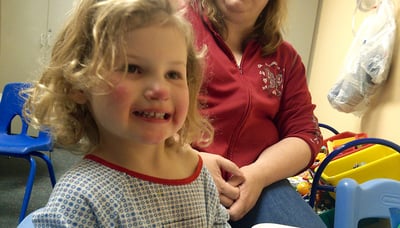
Calming the storms in Mackenzie’s brain
In the years following her diagnosis, a host of different medications did little to calm the storms in Mackenzie’s brain. They tried the ketogenic diet — an incredibly restrictive high-fat, low-carb diet that helps alleviate seizures in some patients — but it, too, had no effect. At their worst, Mackenzie was experiencing seizures every two weeks.
“Hers would last 30-40 minutes, if not longer,” Tiffany said. “And we usually had to call an ambulance because the rescue meds we had didn’t work.”
Every time they’d try a new treatment plan or adjust her medications, Mackenzie would spend several days in the EMU.
“I couldn’t even count the days — there were a lot,” Tiffany said. “Several times a year, ranging from days to weeks.”
There are three primary functions of the EMU: to confirm a diagnosis of epilepsy, to rule out a diagnosis or to evaluate medication levels. While in the EMU, patients are hooked up to an EEG 24/7 while a team of doctors and nurses monitor every second of brain activity in a nearby control room. High-definition cameras capture the patient’s every movement.
“Every case of epilepsy is unique. That means every diagnosis, treatment plan and follow-up care must be specifically tailored to the patient,” said Dr. Hecox. “We use advanced neurodiagnostic monitoring, which allows our specially trained epileptologists to track brain activity down to the millisecond. When a seizure occurs, they’re able to pinpoint its precise origin and the cameras allow them to determine what, if any, external forces have caused it. Armed with that information, we’re then able to devise a treatment that best suits each individual child.”
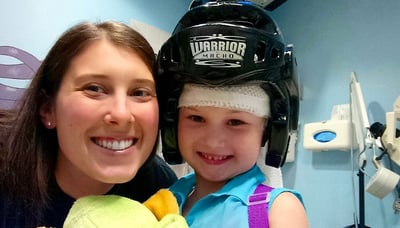
Having little luck with conservative approaches, in July 2014, Tiffany and her husband, Phil, opted for surgery to remove the part of Mackenzie’s brain Dr. Hecox believed was causing the seizures. She spent two weeks in the EMU. Unfortunately, that surgery offered only temporary relief. After a few months the seizures returned.
Most recently, in November 2016, Mackenzie underwent another brain surgery and another two week stay. In this procedure, doctors disconnected her temporal parietal occipital (TPO) — a complex section on the left side of the brain that is partially responsible for language, spatial and object recognition, writing and reading.
As a result of the surgery, she lost the peripheral vision on her left side. She’s also been seizure-free ever since.
While Mackenzie’s journey is far from over, her family is hopeful. They’re hopeful because for the first time in five years they might be able to start reducing her medications. They’re hopeful because the good days continue to outnumber the bad. They’re hopeful because Mackenzie’s spirit remains unwavering — through everything she still smiles so wide that her eyes squint. And they’re hopeful because if they’re needed, the care team at Children’s Wisconsin Epilepsy Monitoring Unit will be there.
Children's Wisconsin Resources

Written by
Evan Solochek
Writer
Related Stories
No related articles found.



